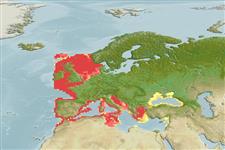Common names from other countries
>
Gadiformes (Cods) >
Gaidropsaridae (Rocklings)
Etymology: Gaidropsarus: Greek, ga, ge = the earth + Greek, ydro = water + Greek psaros = speckled, starling (Ref. 45335).
More on author: Linnaeus.
Environment: milieu / climate zone / depth range / distribution range
Ecología
marino; salobre demersal; oceanodromo (Ref. 51243); rango de profundidad 1 - 450 m. Temperate; 5°C - 18°C (Ref. 12468); 62°N - 33°N, 10°W - 42°E
Eastern Atlantic: southern Norway, around the western shores of the British Isles to the southwestern European and northwestern African coasts, and southern European coasts in the Mediterranean Sea, into the Black Sea, .
Tamaño / Peso / Age
Maturity: Lm ? range ? - ? cm
Max length : 50.0 cm TL macho / no sexado; (Ref. 1371)
Espinas dorsales (total): 0; Espinas anales 0. First dorsal-fin ray followed by a few small fleshy filament. Color varies, brown sometimes reddish and with a vermiculated or mottled pattern dorsally. Paler ventrally. The median fin borders dark (Ref. 1371). One barbel on the lower jaw and two on the snout. Marbled coloration on the back (Ref. 35388).
Lives generally at shallow depths near the shores on rocky bottom with aquatic vegetation to 60 m depth. Feeds on fish, crustaceans, worms and algae. Sold fresh in markets, also made into fish meal (Ref. 1371). Caught as a by-catch by various fishing gears (Ref. 35388).
Life cycle and mating behavior
Madurez | Reproducción | Puesta | Huevos | Fecundidad | Larva
Cohen, D.M., T. Inada, T. Iwamoto and N. Scialabba, 1990. FAO species catalogue. Vol. 10. Gadiform fishes of the world (Order Gadiformes). An annotated and illustrated catalogue of cods, hakes, grenadiers and other gadiform fishes known to date. FAO Fish. Synop. 125(10). Rome: FAO. 442 p. (Ref. 1371)
IUCN Red List Status (Ref. 130435)
CITES (Ref. 128078)
Not Evaluated
Threat to humans
Harmless
Human uses
Pesquerías: escaso valor comercial
Más información
ReferenciasAcuiculturaPerfil de acuiculturaRazasGenéticaElectrophoresesheritabilidadEnfermedadesProcesamientoMass conversion
Herramientas
Special reports
Download XML
Fuentes de Internet
Estimates based on models
Preferred temperature (Ref.
115969): 7 - 15.2, mean 10.1 (based on 505 cells).
Phylogenetic diversity index (Ref.
82804): PD
50 = 0.5001 [Uniqueness, from 0.5 = low to 2.0 = high].
Bayesian length-weight: a=0.00417 (0.00311 - 0.00559), b=3.08 (3.00 - 3.16), in cm Total Length, based on LWR estimates for this species (Ref.
93245).
Nivel trófico (Ref.
69278): 3.5 ±0.3 se; based on diet studies.
Resiliencia (Ref.
120179): Alto, población duplicada en un tiempo mínimo inferior a 15 meses (Preliminary K or Fecundity.).
Fishing Vulnerability (Ref.
59153): Low to moderate vulnerability (26 of 100).
